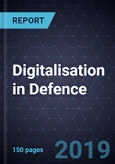Commercial Business Models Challenging Traditional Defence Business Patterns
The rise of digital platforms is empowering the military, enabling better continuity of operations and bringing armed forces at a new level of combat readiness. However, the Digital Transformation is also bringing new players into the market place, where traditional industries have been used for decades to well-established business and working processes. From now on, a progressive impregnation of commercial services is witnessed across the military, with a growing appetite for aaS models, ready for deployment, data monetization and pay as you go types of services, due to constrained defence budgets.
Digital transformation of the military ecosystem has started its journey, shifting traditional working processes, operations and level of services with a deep impact on delivering military capabilities.
Digital technologies, such as the Internet of Things (IoT), Cloud Computing, Big Data, Data Analytics, Artificial Intelligence, Augmented Reality, and Blockchain are being progressively leveraged at both the agency and operational levels to ease workflow and bring more efficiency to missions.
However, there are several roadblocks slowing down defence digitalisation due to the lack of technical maturity of these new technologies and the overall lack of security around them. Security is actually a crucial point, where a large spectrum of threats and concerns holds military authorities from moving forward, right from ensuring data integrity, its protection, to where it is hosted.
Similarly, these factors delay external player’s market penetration, notably from the IT sector and leading companies such as Amazon, Google, Microsoft, IBM, Cisco, etc. as these companies do not have all the military standards and required certifications to be vetted by military entities and budget holders. There are also some concerns amongst military end users on the robustness of these new technologies in the environments they operate in. Besides, social acceptance within these IT conglomerates is also a key parameter to consider, with potential effects on further market penetration.
Moreover, unlike any other commercial industries (retail, mobility, automotive, energy, chemicals, commercial aerospace and space, mass transport, etc.), the military ecosystem envisions digital transformation as another tool in the toolbox and will invest in it only when essential benefits can be realised (life safety, faster deployments, ease of operability, etc.). Each of these relevant aspects is included in this report, with use cases and actual and/or upcoming applications, and what are the main drivers and restraints behind these adoptions.
This study also provides perspectives on the changing competitive landscape globally, assessing how defence players are already digitally fluent and their strengths to embrace the transformational journey. Finally, this study includes in-depth analysis of the digital transformation impact on traditional business models. A key focus on new approaches to outsourcing is also included, especially in the light of the “as-a-Service” model. Digital transformation also brings a new horizon focusing on data and dealing with an ever growing flow. What does this mean for the military industry and future business opportunities? This study also aims to reply to this question by exploring potential and likely avenues to monetise data in the military ecosystem
Table of Contents
Companies Mentioned (Partial List)
A selection of companies mentioned in this report includes, but is not limited to:
- Amazon
- Cisco
- IBM
- Microsoft








